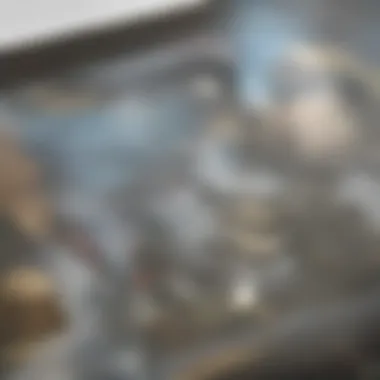The Comprehensive Guide to Unplugging a Drain


Intro
Unclogging a drain is a task most homeowners will encounter at some point. The complexity can range from a simple hair clog in the bathroom sink to a more serious blockage in the kitchen or basement. Understanding the necessary methods and the tools available for these tasks can transform frustration into a manageable chore. This guide will delve into various techniques, equipment, and preventative strategies to effectively maintain your plumbing.
In addressing the process of drain maintenance, we will cover crucial points including the importance of regular inspection, the methods of unclogging, and an overview of tools commonly used in plumbing repairs. Through this, readers will gain insight that not only resolves current issues but also equips them with knowledge to prevent future problems.
Key Tips:
- Regularly inspect drains to catch early signs of clogs.
- Utilize specific tools like plungers or snakes for effective unclogging.
- Implement preventative measures to maintain smooth plumbing function.
This comprehensive exploration seeks not only to educate but also to empower homeowners with confidence in handling common plumbing issues. Now, let's begin this guide by examining the various methods used to address clogs.
Understanding the Basics of Drainage Systems
Understanding drainage systems is a key foundation for effective home maintenance and plumbing management. Every homeowner should grasp how their drainage system works since this knowledge can prevent minor inconveniences from developing into serious problems. Basic comprehension empowers the homeowner to identify issues early, take preventative action, and efficiently engage in the process of unplugging a drain when necessary.
Components of a Drainage System
The components of a drainage system are essential to its function. Each part plays a role in ensuring that wastewater moves efficiently away from the home. Here are the key elements:
- Pipes: The primary channels that transport wastewater away from sinks, toilets, and other fixtures.
- Traps: U-shaped sections of pipe that maintain water barriers to prevent sewer gases from entering the home while allowing liquids to flow.
- Vent pipes: These allow air into the drainage system, preventing vacuum formation that can disrupt flow.
- Cleanouts: Access points installed at various locations in the system for maintenance and clearing clogs.
- Sewage lines: Larger pipes that carry waste from multiple fixtures to the municipal sewer system.
Each component must be maintained properly. Failure in any part can lead to blockages or leaks, leading to more significant issues.
Common Causes of Drain Clogs
Several factors contribute to the decking of drains. Understanding these common causes can aid in early identification and remediation. Here are notable culprits:
- Hair: Often responsible for clogs in bathroom sinks and tubs.
- Grease: Common in kitchen drains, it solidifies over time, leading to blockages.
- Food waste: Even small bits can accumulate and cause issues, particularly in garbage disposals.
- Soap residue: Over time, soap can build up and restrict flow.
- Foreign objects: Items accidentally washed down the drain can create immediate obstructions.
"Recognizing the causes of clogs helps in taking preemptive measures, reinforcing the structure and function of your drainage systems."
Homeowners should consider regular cleanings and mindful disposal of waste to mitigate these issues. By understanding the basics of drainage systems, individuals can ensure their plumbing remains functional and efficient.
Initial Assessment of Drain Issues
Understanding how to assess the condition of your drains is a foundational step in successfully addressing clogs. Recognizing drain issues early can save homeowners both time and money. A prompt assessment can avoid the escalation of problems, which may lead to more severe plumbing issues requiring professional intervention. Performing an initial evaluation involves identifying specific signs of a clog and gauging its severity. This knowledge is crucial for selecting the right tools and methods needed to resolve the issue effectively.
Signs of a Clogged Drain
A clogged drain often gives noticeable signs before it worsens. It’s essential to pay attention to these indicators to act in time. Some common signs include:


- Slow drainage: Water takes longer than usual to empty from sinks, tubs, or toilets.
- Unpleasant odors: Foul smells emanating from drains indicate stagnation and buildup.
- Gurgling sounds: Air escaping through an obstruction can create unusual sounds.
- Backflow: Water or waste rising back up through the drain is a sign of serious clog.
- Visible debris: Hair, soap, or other debris around the drain can suggest a blockage.
Recognizing these signs early can allow you to address minor issues before they develop into significant blockages. Therefore, regular observations of your plumbing systems are advised.
Determining Severity of the Clog
Once signs have been identified, the next step is to assess how severe the clog is. This assessment influences how you proceed with unclogging. Here are a few factors to consider:
- Duration of symptoms: If the issue has persisted for days, it's likely more severe.
- Extent of blockage: If multiple drains are affected, the problem could be deeper in the plumbing system.
- Type of drain: Some drains, like kitchen sinks, are more prone to severe blockages due to grease buildup.
- Recurrent issues: Frequent clogs in the same area often indicate a more significant underlying problem.
Understanding the severity of the clog is vital. This influences whether you can use basic tools, like a plunger or snake, or if you need to resort to more advanced techniques or professional assistance.
"A knowledgeable homeowner can often prevent small drain problems from becoming major plumbing disasters."
By performing a thorough assessment of your drain issues, you can increase the effectiveness of your unclogging efforts. This foundational step is crucial for maintaining a well-functioning plumbing system.
Tools and Materials for Unclogging Drains
Understanding the proper tools and materials for unclogging drains is vital. Using the right equipment can make the process smoother and more effective. Homeowners often face clogged drains, which can lead to costly repairs if not addressed promptly. By having the right tools, you can manage minor clogs yourself, saving both time and money.
Essential Tools for Homeowners
Homeowners should consider investing in a few key tools.
- Plunger: A plunger is often the first tool to reach for during a blockage. Its design allows for the creation of suction, which can dislodge minor clogs. Choose a flange plunger for toilets and a cup plunger for sinks.
- Drain Snake: A drain snake, or auger, is another practical tool. This flexible device can reach deeper blockages that a plunger cannot. It operates by breaking up clogs or retrieving tangled hair or debris.
- Bucket: A bucket is essential when dealing with clogged drains. It helps catch any overflow, minimizing potential mess and damage. Instead of allowing it to spill across your floor, a bucket keeps the area tidy.
- Gloves: Protecting your hands is crucial. Rubber gloves keep hands clean and sanitary while dealing with unpleasant blockages.
- Flashlight: Having proper lighting is necessary for inspecting drain areas. It helps identify issues, ensuring you can address them effectively.
By keeping these tools accessible, homeowners are better equipped to handle common plumbing issues. Regularly checking their condition ensures optimal performance when needed.
Chemical Unclogging Solutions
While manual tools are essential, sometimes chemical solutions can provide a more straightforward approach. Chemical unclogging solutions often dissolve obstructions through powerful formulations.
- Enzymatic cleaners: These use natural enzymes to break down organic matter. They are often safe for regular use and can help prevent future issues.
- Acidic drain cleaners: These can clear stubborn clogs, but caution is necessary. They may damage pipes if misused. Always read the instructions carefully.
- Baking Soda and Vinegar: A natural alternative is a mixture of baking soda and vinegar. This combination creates a fizzy reaction that may dislodge small clogs without harsh chemicals.
Effective Techniques for Unplugging Drains
Effective techniques for unplugging drains are crucial for homeowners to understand. Knowing the proper methods can transform a potentially frustrating scenario into a manageable task. Clogs can arise due to various factors, and using the right technique can save both time and resources. Below, we explore a few established techniques that can effectively resolve drainage issues.
Using a Plunger
Utilizing a plunger is often the first step many homeowners take when faced with a clogged drain. The design of a plunger features a rubber suction cup, which allows it to create a vacuum seal over the drain. It is important to choose the right type of plunger: a cup plunger is suited for flat surfaces like sinks, while a flange plunger works better for toilets.


To use a plunger effectively, follow these steps:
- Fill the sink or tub with enough water to cover the plunger's cup.
- Position the plunger over the drain, ensuring a tight seal.
- Push down and pull up rapidly without breaking the seal. Repeat this motion several times.
- Check if the clog has cleared by watching the water drain away.
This technique is simple yet effective for minor clogs. It is always advisable to wear gloves and ensure hygiene standards while performing this task.
Employing a Drain Snake
When clogs persist beyond the reach of a plunger, employing a drain snake is a next logical step. A drain snake is a flexible tool that can navigate through pipes, dislodging blockages.
Here’s how to use a drain snake:
- Insert the snake into the drain until you feel resistance, which likely indicates the clog.
- Rotate the handle to either break up the clog or latch onto it.
- Pull the snake back slowly, bringing debris with it.
- Dispose of the debris in a trash bin, and repeat if needed until the drain flows freely.
This tool is invaluable for more stubborn blockages. It is crucial to do this carefully to avoid damaging the pipes.
Implementing Hydro Jetting
Hydro jetting is a more advanced method, ideal for significant or recurring drain problems. It involves the use of high-pressure water jet streams to clean the inside of the pipes. This technique can effectively remove grease, mineral deposits, and other build-up that simpler methods cannot address.
Before undertaking hydro jetting, consider the following:
- Assess the pipe’s condition: Older pipes may not withstand high-pressure water.
- Hire a professional if unsure about performing hydro jetting yourself. This method requires expertise and specialized equipment.
- Plan for potential aftercare, as it may temporarily loosen other blockages elsewhere in the system.
Hydro jetting can restore pipes to their original condition, allowing for better drainage and flow.
In conclude, understanding these techniques provides homeowners with the knowledge necessary to confront and resolve drainage issues. Mastery over various unclogging methods not only aids in maintaining plumbing functionality but also contributes to a more efficient household management.
Preventative Measures to Avoid Future Clogs
Preventative measures play a vital role in maintaining fully functioning drainage systems. Taking the time to implement these measures not only prolongs the life of pipes but can also save considerable time and money associated with drain issues. By focusing on prevention, homeowners can significantly reduce the frequency and intensity of clogging incidents. This section covers essential tips and education that can empower residents to manage their plumbing systems effectively.
Regular Maintenance Tips
Routine maintenance is fundamental for the longevity of any drainage system. Simple tasks can prevent severe issues from arising. Here are some effective maintenance tips to consider:
- Regular Cleaning: Cleans drains regularly to remove buildup. Use hot water or a mixture of vinegar and baking soda to help dissolve grease and grime.
- Checking for Tree Roots: If trees are nearby, inspect for roots that may infiltrate pipes. Address any issues promptly to avoid more significant damage.
- Maintain Grates and Covers: Ensure that any grates or covers over drains are clean and free from debris.
- Use Strainers: In sinks and showers, mesh strainers can catch hair and food particles, preventing them from entering the pipes.
- Inspect Your Plumbing: Conduct periodic checks on pipes and connections. Look for leaks, unusual wear, or misalignments.
By incorporating these strategies, homeowners create a proactive environment against potential clogs, fostering a sense of security with their plumbing systems. Regular maintenance becomes essential for efficient home management.
Educating Household Members


Educating all household members about proper drainage care is an underappreciated aspect of prevention. When everyone in the home understands the do’s and don’ts, the chances of clogs can diminish significantly. Here are some key points to cover:
- What Can Go Down the Drain: Teach family members what materials are safe to dispose of. Items like grease, coffee grounds, and fibrous vegetables should always be disposed of in the trash, not the sink.
- Importance of Routine Checks: Encourage everyone to report any signs of slow drains or unusual noises. Prompt reporting can lead to early interventions and mitigate major issues.
- Emphasizing the Use of Strainers: Explain the benefit of using strainers in sinks and tubs. This simple addition dramatically reduces the chance of debris entering the plumbing system.
Regular and comprehensive education ensures that all individuals in the household are on the same page when it comes to maintaining the drains. Such practices cultivate a collective responsibility that is highly beneficial for preventing clogs.
Consistently educating family and implementing practical maintenance routines can keep drains flowing smoothly, saving time and resources in the long run.
When to Call a Professional
When considering the topic of drain maintenance, knowing when to bring in a professional is crucial. Many homeowners may be tempted to take on stubborn clogs themselves. However, there are specific signs and scenarios where professional assistance becomes not just advisable, but necessary. Attempting to fix complicated issues without the right expertise can lead to further damage and increased costs.
Identifying Complicated Issues
Recognizing the indicators of complicated drainage problems is the first step in deciding to call a plumber. Common signs that suggest professional help may be needed include:
- Multiple drains slow simultaneously: If you find that not just one, but several drains in your home are backing up, it could signal a deeper blockage in the main sewage line.
- Persistent odors: Foul smells emanating from drains can indicate issues like sewage backup, which require immediate attention to prevent health hazards.
- Frequent clogs: Regularly experiencing clogged drains may suggest systemic issues, such as tree root intrusion or broken pipes.
- Gurgling sounds: Noisy pipes after using water can indicate air trapped in the sewer lines, possibly due to a more severe blockage large enough to affect overall flow.
If you notice these signs, it is best not to wait.
Benefits of Professional Services
The advantages of hiring a professional plumber extend beyond just repairs. They provide an array of benefits that can ultimately save you time and hassle. Here are some key benefits of engaging professional plumbing services:
- Expert Diagnosis: Professionals utilize advanced equipment and techniques to identify the root cause of a problem accurately. They avoid guesswork, which can lead to unnecessary repairs or costs.
- Effective Solutions: Trained plumbers are well-versed in the latest methods for drain cleaning and repair. Their experience allows them to tackle even the most stubborn clogs effectively.
- Time-Saving: Attempting to resolve complex issues without expertise can consume a lot of time and may still not fix the problem. Professionals can often complete the task quicker due to their experience and tools.
- Preventative Maintenance: A professional can provide recommendations for regular maintenance and checks to keep your drains clear, reducing future risks of clogs.
Ultimately, calling a professional can be a smart investment in maintaining the integrity of your home's plumbing system.
Concluding Thoughts on Drain Maintenance
Proper drain maintenance is crucial for the longevity and functionality of a home's plumbing system. Without regular attention, minor issues can escalate into major blockages or extensive damage, leading to costly repairs. Throughout this article, we have explored various methods and tools for unplugging drains. Understanding these approaches equips homeowners with the knowledge to handle minor clogs and maintain their drainage systems effectively.
Summary of Key Points
- Understanding the drainage system's components—Knowing the elements that comprise a drainage system helps in identifying potential issues before they worsen.
- Identifying signs of clogs—Recognizing the early symptoms of a clogged drain can save time and resources.
- Utilizing appropriate tools—Employing the right tools such as plungers and drain snakes is essential for resolving clogs without damaging pipes.
- Implementing effective techniques—Different techniques, from basic plunging to hydro jetting, serve distinct purposes and can yield varying results based on the severity of the clog.
- Adopting preventative measures—Regular maintenance practices, including cleaning and educating household members about proper waste disposal, can significantly reduce the likelihood of clogs reoccurring.
In summary, a proactive approach towards drain maintenance is key. This involves monitoring the system, using effective unclogging methods when necessary, and practicing regular care to avoid complications.
The Importance of Preventative Care
Preventative care in plumbing can be likened to regular health check-ups. Postponing regular scrutiny of your drainage system can lead to significant issues down the road. By engaging in preventative measures, homeowners can benefit immensely in several ways:
- Cost-Effectiveness: Addressing small issues before they escalate helps in avoiding expensive repairs.
- Minimized Disruption: Regular checks ensure that drains function smoothly, reducing the inconvenience caused by unexpected clogs.
- Extended Lifespan: When drains are well-maintained, it increases their overall efficiency and lifespan, reducing the need for replacement.
Culmination
"An ounce of prevention is worth a pound of cure."
Investing time in preventative care will result not only in more efficient plumbing but also in peace of mind. By applying the knowledge in this guide, you can ensure a cleaner, healthier, and more functional home environment.







